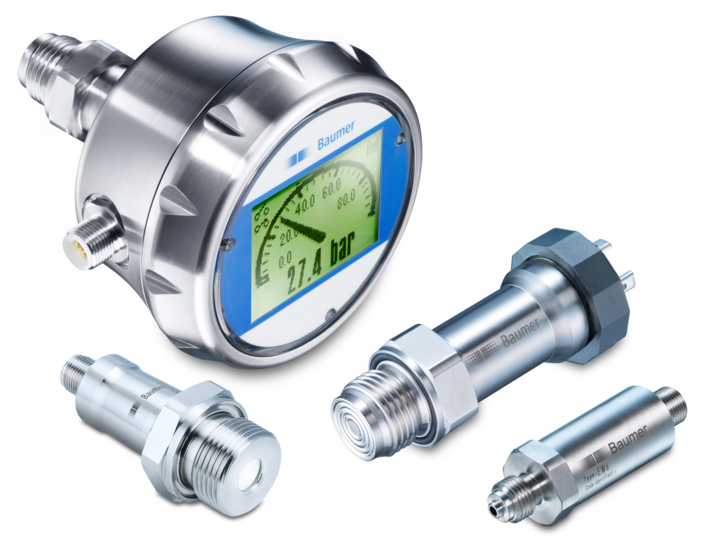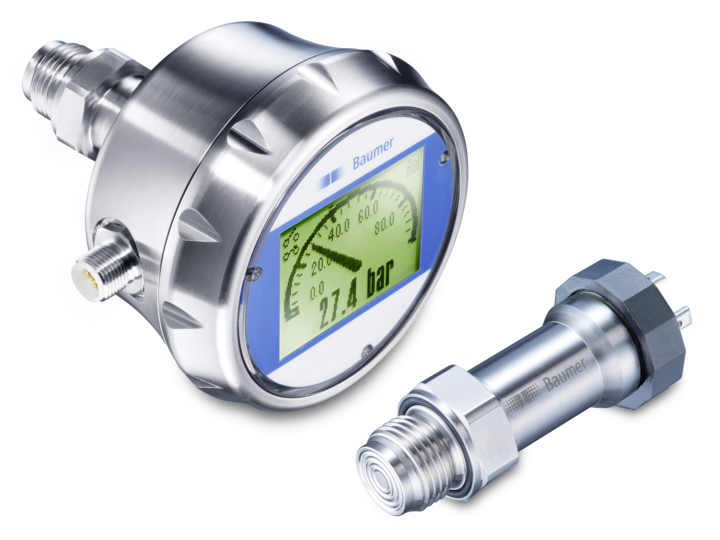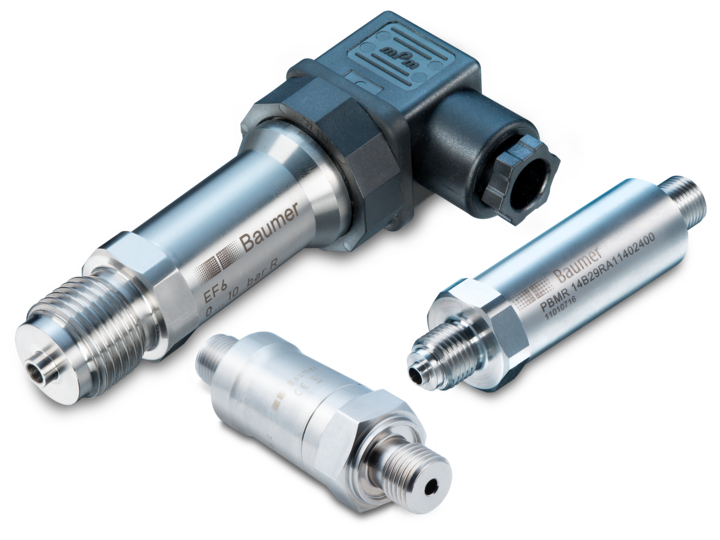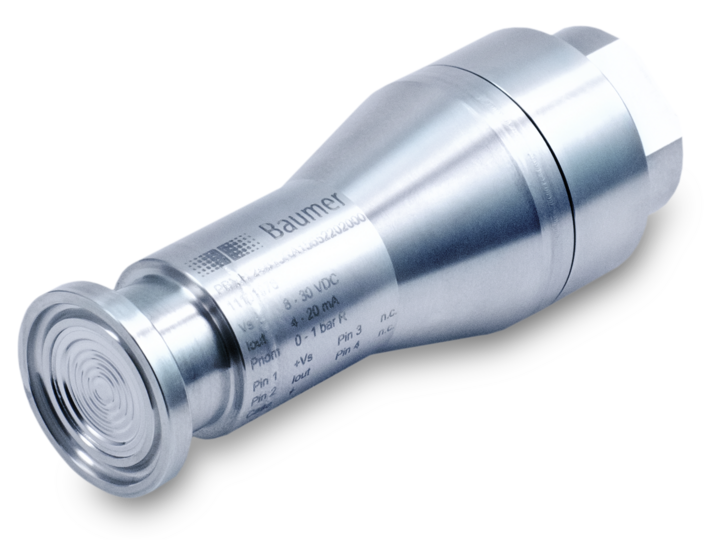什么是压力传感器?
压力传感器是如何工作的?
压力传感器利用膜片在压力作用下引起的形变来测量压力。这种形变通过不同的传感器技术转换成电信号,以便进行处理并传输到外部设备,从而用于监测和控制与压力相关的过程。压力测量是过程技术中设备和系统监测与控制领域最重要和最常用的技术之一。堡盟为各种应用提供广泛的压力传感器产品组合。
压力传感器的设计与类型
压力传感器主要由以下几个组件构成:在压力变化时会发生形变的测量膜片、压力导入口、各种感应元件(例如压电式、电容式或压阻式)、用于放大和处理信号的信号处理单元、保护外壳以及用于连接外部设备的电气和机械连接。在这些组件的相互作用下,压力传感器在各种压力测量应用中都能提供精确的测量结果。
根据不同的测量原理,压力传感器的类型基本上有以下几种:
- 电阻式压力传感器通过施加在材料上的机械应力引起的电阻变化来测量压力。
- 压电式压力传感器通过压电材料在压力作用下发生的电荷移动产生电压。
- 电容式压力传感器可检测因膜片形变导致电容器发生的电容变化。
- 电感式压力传感器通过磁芯或磁性膜片移动时线圈电感发生的变化来测量压力。
- 采用霍尔元件的压力传感器利用霍尔效应来测量压力变化。
- MEMS压力传感器通过硅芯片上的微机械结构来测量压力。
堡盟专注于常见的电阻式压力传感器和压阻式压力传感器。更多信息,请点击堡盟压力传感器。
压力测量原理
绝压
绝压是指相对于完全真空的压力,因此始终以正值表示,常见的单位有Pa、bar或Psi (abs)。测量绝压的传感器以真空为基准,通常使用的有MEMS传感器、电容式传感器和压阻式传感器,它们通过检测膜片的形变或电气特性的变化来测量压力。
典型应用领域:
- 监控或控制与绝压(如灭菌器或高压灭菌型蒸锅中的蒸汽压力)有关的物理过程
- CIP/SIP清洗
- 真空泵
表压
表压是指相对于当前气压的压力,可以正值表示,也可以负值表示,常见的单位有Pa、bar或Psi (gauge)。表压传感器需要定期进行校准,并且有不同的传感器技术可选。压电式和电容式传感器可将压力变化转换为电信号。这些传感器通常提供通风孔,以便将大气压作为基准。
典型应用领域:
- 非密封容器中的静压液位测量
- 通过真空保持对工件的夹持力
- 液压或气压系统的压力测量
差压
差压是指系统中两个压力之间的差值,可以正值表示,也可以负值表示。差压常见的单位有Pa、bar或Psi,可通过电容式和压电式压力传感器等各种传感器技术测量得出。差压传感器对环境条件不甚敏感,需要定期进行校准。此外,差压也可以通过两个单独的传感器来测量,这两个传感器分别向控制单元提供一个信号,由此来计算差压。
典型应用领域:
- 封闭容器中的物位测量
- 液体的流速测量
- 滤膜堵塞检测
关于常见压力单位换算的更多信息,请点击单位换算表。

压力传感器技术
温度影响和温度公差
环境温度和介质温度对压力传感器的精度有很大的影响。传感器的温度公差决定了其在不同温度下能够达到的精度。
标准测量误差和/或最大测量误差是相对于参考温度(通常为20°C)规定的。但是,传感器的工作温度通常不是20°C,也并非始终不变,这样就会影响标准测量误差和最大测量误差,从而影响测量结果。
因此,当传感器的工作温度偏离参考温度(例如20°C)时,必须考虑传感器的标准测量误差或最大测量误差。如果传感器工作温度偏离了参考温度(例如20°C),应首选初始精度较低但具有较高温度稳定性的压力传感器,而非初始精度较高但温度稳定性不高的压力传感器。
温度对最大测量误差的影响

误差定义
堡盟规定了产品的“最大误差率”,即从统计角度看,保证99.7%的堡盟传感器符合技术规格。部分竞争对手的产品采用“典型误差率”,即他们有32%的产品不符合技术规格。

点击此处获取堡盟技术指南:“压力传感器技术规格的准确解释”
灭菌过程中的压力
高温蒸汽常用于各种装置和系统的灭菌。传感器(如PBMH高压灭菌型)等小尺寸压力传感部件,可在高压灭菌型蒸锅中灭菌。对于大型装置,可将高温蒸汽导入整个系统,即所谓的“现场灭菌”(SIP)。因此,尽管在灭菌过程中传感器通常不会评估信号,但它必须设计得很坚固耐用,能够承受灭菌过程中常见的温度和压力(例如:温度134°C,压力3 bar,持续时间30分钟)。从物理角度来说,压力和温度直接相互影响,如以下饱和蒸汽曲线所示。

堡盟PBMx和PFMx压力传感器是控制灭菌过程的理想选择。即便在温度变化很快的情况下,它们也可以提供准确的测量值。这样,根据温度和压力的对应关系,通过监控压力就能实现可靠的过程控制。

专用术语及其关系解释

- 精确度:指单次测量值相对于多次测量平均值的可能偏差,可用“散布圆”来表示。圆越小,精确度越高;圆越大,精确度越小。
- 精度:指多次测量平均值与真实值之间的误差。误差越小,精度越高;误差越大,精度越低。
- 标准测量误差:通过最佳拟合直线(BFSL)得到,用于表示精确度(散布圆)。
- 最大测量误差:包括了标准测量误差和传感器的固定误差。
单位换算表











